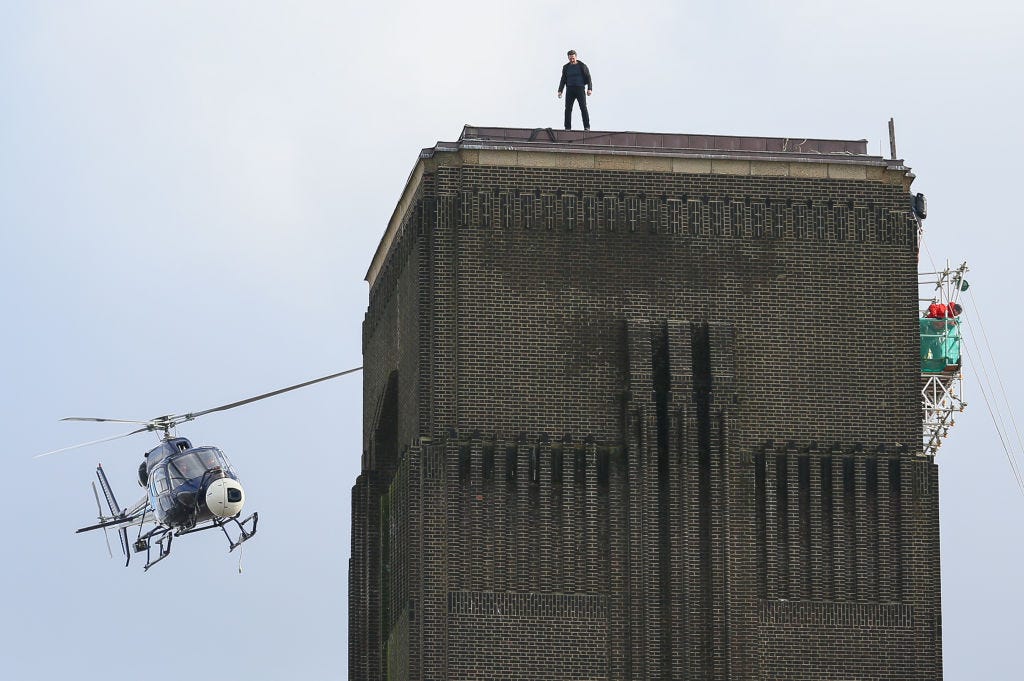A few weeks ago, we wrote two issues about the Curzon cinema being unceremoniously elbowed out of its Mayfair home by its landlords (by the way, the petition to save the Curzon has jumped up by a few thousand signatures in that time, but if you haven’t signed it yet, there’s still time.)
While we were putting those issues together, it occurred to us that there was a distinct irony in the fact that, while secretive oligarchs are busy shutting down London’s cultural institutions, the city itself has never been more in demand as a backdrop for films and TV shows.
Even if we just look at Netflix’s recent activities, there’s the latest season of You, the Jamie Foxx/Cameron Diaz movie Back in Action, the third series of Bridgerton, Lockwood & Co, The Strays, and the Luther movie - all of which have been filmed, at least partly, on the streets of London.
The origins of this boom can be traced back to the mid-2010s, when George Osborne introduced a series of very generous tax breaks aimed at studios like Disney, which was looking for somewhere to film its Star Wars spin-offs at the time. Pinewood studios has done very well out of that relationship since The Force Awakens was filmed there, and that relationship has continued right through to more recent productions like Andor. If this recent Times article is to be trusted, Andor cost Disney £202.9 million to make, but those costs were “partly offset by a £39.8 million tax credit, the smallest of the rebates received by Disney for a Star Wars production”.
Just last week it was announced that Pinewood Studios has been granted planning permission for a 1.4m sq ft expansion, and that comes on top of news that Netflix is going to double the size of its Shepperton studios with a £500m expansion, and the imminent arrival in Dagenham of “London’s largest film and television production center”.
This is all great fodder for the mayor’s press team, who can argue that all that lost tax money is more than made up for by the creation of hundreds of jobs and all the work that gets created in related industries (like special effects studios). That’s why the mayor has been putting out press releases boasting about the “more than £19 million” he has invested into the film industry in the last five years, and the fact that there are “40 films and TV series shooting on the streets of the capital every day”.
But almost every boom has its bust and, sure enough, there are a couple of existential threats emerging to ‘LA-on-Thames’.
Tax Driver
Threat number one comes from the tax man or, to be more precise, the Valuation Office Agency, which is the bit of the government that values properties so they know how much to charge for things like council tax and business rates.
Last month, the FT reported that “Pinewood Studios has been hit with a fourfold increase in its ‘rateable value’, which is used to determine business rates, while Shepperton and the Warner Brothers site have been hit with a fivefold rise.”
Last week, the studios sat down with the VOA for what were inevitably described as “crunch talks” and, as a result, The VOA is embarking on a bunch of inspections of the studios to try and figure out how much rent someone might pay for them if they were available on the open market.
One of the reasons the value of these sites is going up is because they’re highly “sought after by ecommerce retailers and logistics groups”. Which is ironic when you consider that mega-ecommerce retailer Amazon took out a ten-year lease on 450,000 sq ft of space at Shepperton Studios this time last year, for their Prime Video division.
What will Tom Cruise jump off now?
The other threat is aimed more at those production companies filming on the city’s streets, in people’s houses, or in offices on a Friday when all the real people are working from home.
Location scout James Hanford, told City AM last week that nobody wants Big Ben or the London Eye in their productions because they’re too obvious. Instead, they’re after “high quality office buildings, clad in diverse materials” and “streets lined with Victorian lampposts”.
Even more in demand though are “the capital’s derelict patches of disused land” and crumbling industrial buildings. These are the types of places that are “great for filming but also they have space for offices and people doing stunt scenes like Tom Cruise jumping off a roof”.
The problem is, there are only a few of these places left, and those that do remain are quickly being gobbled up by developers.
Think of all the things that were filmed in Battersea Power Station when it was still a shell. Or the old St Pancras Hotel. Or what still gets filmed at the Millennium Mills in Silvertown.
Once redevelopment takes all those sites away then London will no longer have that highly attractive mix of world class, money-saving studios and big post-industrial spaces that are just down the road.
At least we can be sure that all those new developments will provide plenty of affordable housing for the residents of London… Right?
“I’m going to make this affordable housing policy disappear”
Remember that scene in The Dark Knight where The Joker does a‘magic trick’ and makes a pencil disappear into a mob guy’s head? Well, that scene was filmed in the kitchens at the Earls Court Exhibition Centre.
Six years after the release of the Dark Knight, the Exhibition Centre was being demolished to make way for a series of urban “villages” designed by Terry Farrell (the man behind Charing Cross Station and the MI6 building in Vauxhall). The then mayor, Boris Johnson, had approved the demolition and 20-year redevelopment plan despite significant opposition from MPs and local residents.
Things started going sideways pretty quickly after Labour took Hammersmith & Fulham from the Tories in 2014 (the site straddles that borough and Kensington & Chelsea). Then, in 2019, developer Capco (who owned the site along with TfL) sold their share for “less than a third of what the redevelopment was originally valued at”.
Things went pretty quiet after that, until last week when a ‘masterplan’ was unveiled that promised to transform the 40 acres of rubble into “an £8 billion green neighbourhood with a raised urban park bigger than Trafalgar Square at its heart” all of which would be ready to move in to “around 2040”.
According to the press release article printed in the Standard, the new ‘neighbourhood’ would consist of “4,500 new homes, of which around 35 per cent will be classed as affordable.” But the article ends with a spokesperson for Hammersmith & Fulham council declaring (in a delightfully passive aggressive way) that “all successful developments in Hammersmith & Fulham will have a minimum of 50% genuinely affordable homes and we look forward to helping them deliver that.”
Tim Donovan, the BBC’s Political Editor is smart enough to know that 35 is a lower number than 50, and wrote an article declaring that “a major planning row could break out over new plans”. Donovan couldn’t get a peep out of the mayor’s office, but he did get someone from the Earl’s Court Development Company PR team to say that they did “acknowledge the policy requirements and will be delivering the maximum amount of affordable housing possible on this challenging site,” which could be roughly translated as, “we’ll build as many affordable houses as we want and there’s not a lot anyone can do about it.”
For their part, TfL has done nothing to dispel that notion, pointing out that “some sites can have an affordable housing target that is lower than 50% because others will have a higher affordable housing target - up to 100%.”
The history of another Dark Knight location would seem to confirm this relaxed attitude to concepts like ‘commitment’ and ‘policy’ when it comes to housing in London. Battersea Power Station initially had an affordable housing target of just 15%, and even that was reduced to a measly 9% by the time the development was done. We would be very surprised if that 35% number doesn’t go in a similar direction in the next fifteen years or so.
5 little bits
While the Earl’s Court Development Company was busy trying to reduce the amount of affordable housing it has to build, the mayor was announcing funding for “up to 600 new homes for Ukrainian and Afghan refugees”. Introduced as the initial six-month accommodation commitment for those hosting under the Homes for Ukraine scheme comes to an end, the £500m Refugee Housing Programme will allow local authorities to “fund new home acquisitions, including refurbishing existing or newly acquired homes, purchasing new-build properties or developing new homes”.
A year ago, we wrote an issue headlined Should we turn all those empty offices into homes?, which looked at the idea that surplus office space in The City could be converted into homes “as part of mixed-use neighbourhoods” in order to “provide more affordable housing while making neighbourhoods feel safer and more vibrant.” This past week City AM went for a look inside some of “the City of London’s first residential properties in 10 years” and wouldn’t you know it, the development contains “87 luxury apartments” that come with a pool and gym, as well as ‘lifestyle areas’ (whatever they are). The starting price? A snip at “just £625,000”.
Meanwhile, in other TfL construction news, the Silvertown Tunnel is now running £13M over budget, and the opening date has been pushed back again to June (the 1.4km tunnel was originally due to finish in April).
A road that runs in front of the Russian Embassy has been renamed Kyiv Road by Westminster Council. “Placenames across London have changed over the decades to mark momentous points or figures in history,” said Westminster Cllr Adam Hug, “so Kyiv Road is part of that long tradition.”
The BBC has collected a few of the more striking images showing what happens when thousands of Newcastle United fans “take over” Trafalgar Square.



